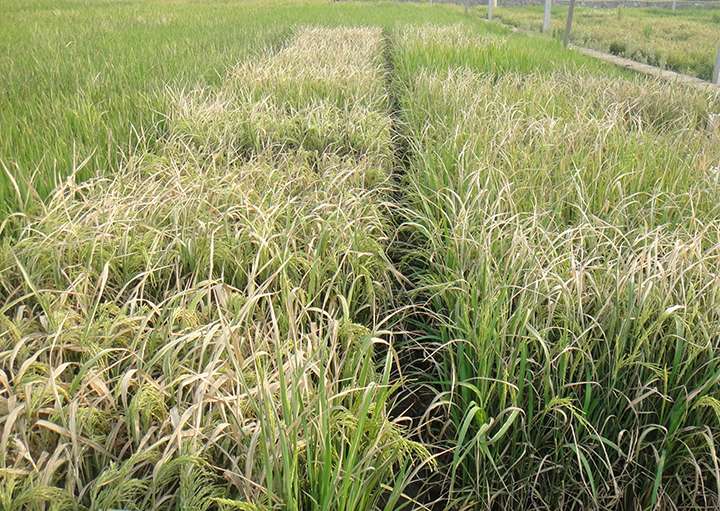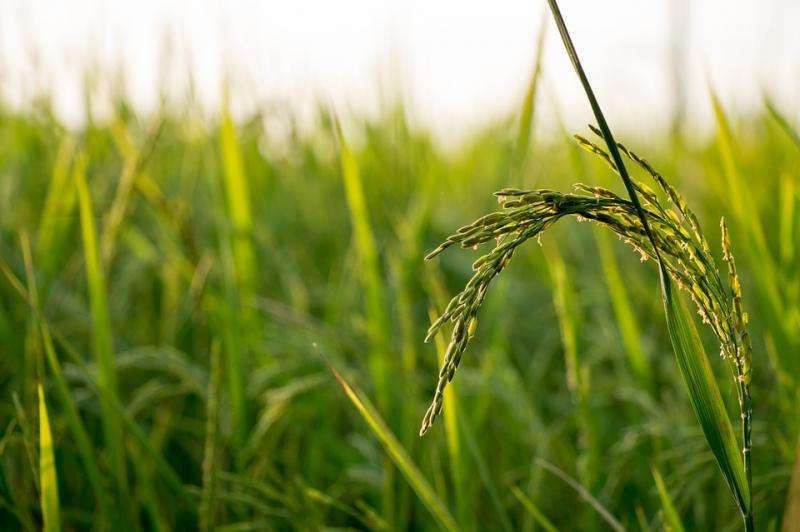Scientists engineer disease-resistant rice without sacrificing yield

Researchers have successfully developed a novel method that allows for increased disease resistance in rice without decreasing yield. A team at Duke University, working in collaboration with scientists at Huazhong Agricultural University in China, describe the findings in a paper published May 17, 2017 in the journal Nature.
Rice is one of the most important staple crops, responsible for providing over one-fifth of the calories consumed by humans worldwide. Diseases caused by bacterial or fungal pathogens present a significant problem, and can result in the loss of 80 percent or more of a rice crop.
Decades of research into the plant immune response have identified components that can be used to engineer disease-resistant plants. However, their practical application to crops is limited due to the decreased yield associated with a constantly active defense response.
"Immunity is a double-edged sword, " said study co-author Xinnian Dong, professor of biology at Duke and lead investigator of the study. "There is often a tradeoff between growth and defense because defense proteins are not only toxic to pathogens but also harmful to self when overexpressed," Dong said. "This is a major challenge in engineering disease resistance for agricultural use because the ultimate goal is to protect the yield."
Previous studies have focused on altering the coding sequence or upstream DNA sequence elements of a gene. These upstream DNA elements are known as promoters, and they act as switches that turn on or off a gene's expression. This is the first step of a gene's synthesis into its protein product, known as transcription.
By attaching a promoter that gives an "on" signal to a defense gene, a plant can be engineered to be highly resistant to pathogens, though at a cost to growth and yield. These costs can be partially alleviated by attaching the defense gene to a "pathogen specific" promoter that turns on in the presence of pathogen attack.
To further alleviate the negative effects of active defense, the Dong group sought to add an additional layer of control. They turned newly discovered sequence elements, called upstream open reading frames (uORFs), to help address this problem. These sequence elements act on the intermediate of a gene, or messenger (RNA, a molecule similar to DNA) to govern its "translation" into the final protein product. A recent study by the Dong lab in an accompanying paper in Nature has identified many of these elements that respond in a pathogen-inducible manner.

The Dong group hypothesized that adding this pathogen-inducible translational regulation would result in a tighter control of defense protein expression and minimize the lost yield associated with enhanced disease resistance.
To test this hypothesis, the researchers started with Arabidopsis, a flowering plant commonly used in laboratory research. They created a DNA sequence that contains both the transcriptional and translational elements (uORFs) and fused them upstream of the potent "immune activator" gene called snc1. This hybrid sequence was called a "transcriptional/translational cassette" and was inserted into Arabidopsis plants.
When plants have snc1 constitutively active, they are highly resistant to pathogens, but have severely stunted growth. Strikingly, plants with the transcriptional/translational cassette not only have increased resistance, but they also lacked growth defects and resembled healthy wild-type plants. These results show the benefits of adding translational control in engineering plants that have increased resistance without significant costs.
The Dong group then sought to apply these findings to engineer disease-resistant rice, as it is one of the world's most important crops. They created transgenic rice lines containing the transcriptional/translational cassette driving expression of another potent "immune activator" gene called AtNPR1. This gene was chosen as it has been found to confer broad spectrum pathogen resistance in a wide variety of crop species, including rice, citrus, apple and wheat.
The transgenic rice lines containing the transcriptional/translational cassette were infected with bacterial/fungal pathogens that cause three major rice diseases—rice blight, leaf streak, and fungal blast. These showed high resistance to all three pathogens, indicating broad spectrum resistance could be achieved. Importantly, when grown in the field, their yield—both in terms of grain quantity and quality per plant—was almost unaffected. These results indicate a great potential for agricultural applications.
This strategy is the first known use of adding translational control for the engineering of disease-resistant crops with minimal yield costs. It has many advantages, as it is broadly applicable to a variety of crop species against many pathogens. Since this strategy involves activating the plants' endogenous defenses, it may also reduce the use of pesticides on crops and hence protect the environment.
Additionally, these findings may be broadly applicable to other systems as well. These upstream elements (uORFs) are widely present in organisms from yeast to humans, with nearly half of all human transcripts containing them. "The great potential in using these elements in controlling protein translation during specific biological processes has yet to be realized," Dong said.
More information: Guoyong Xu et al. uORF-mediated translation allows engineered plant disease resistance without fitness costs, Nature (2017). DOI: 10.1038/nature22372
Journal information: Nature
Provided by Duke University




















